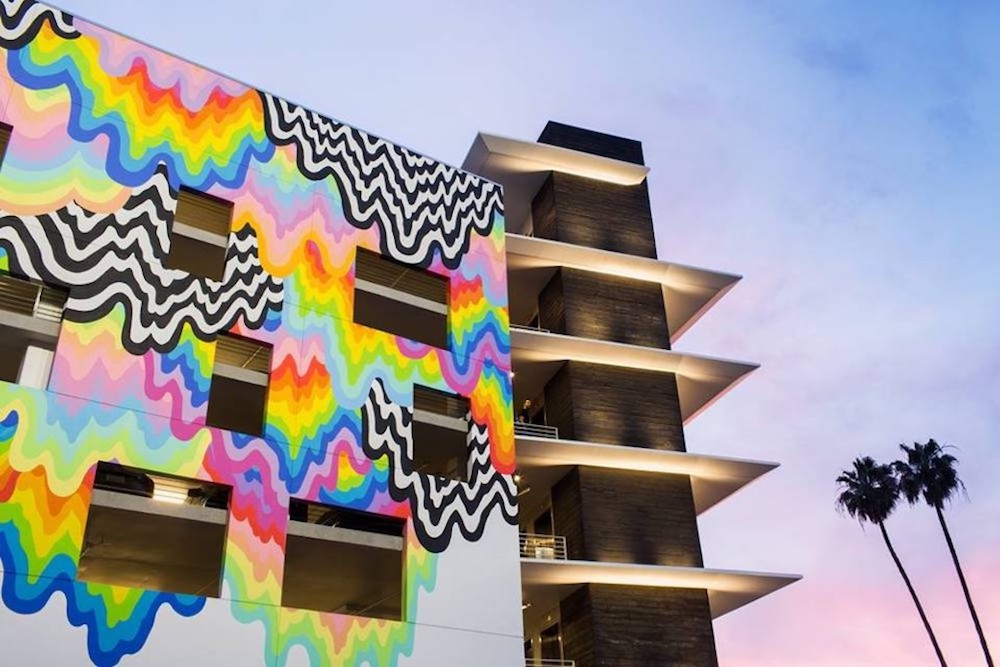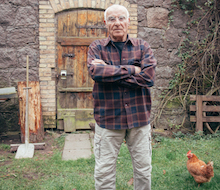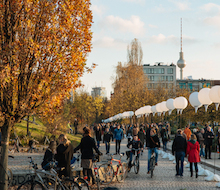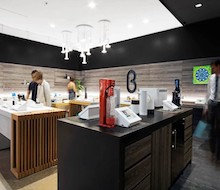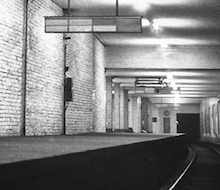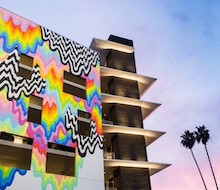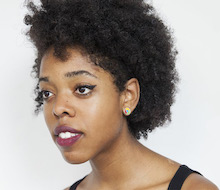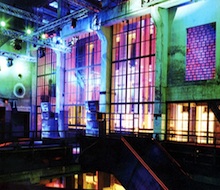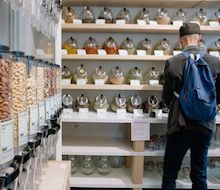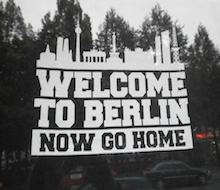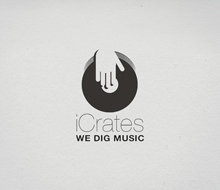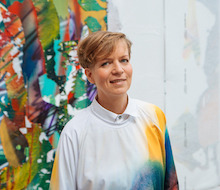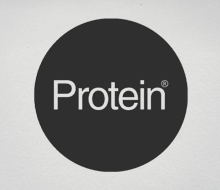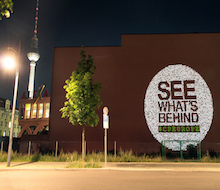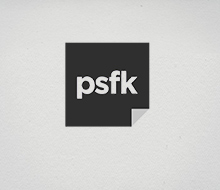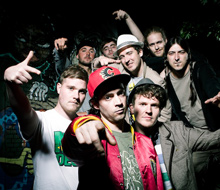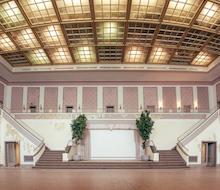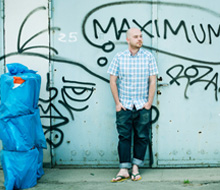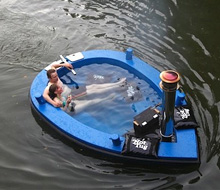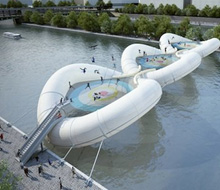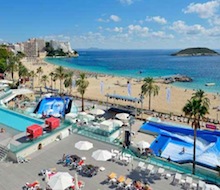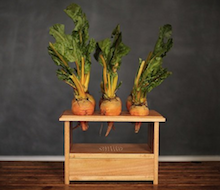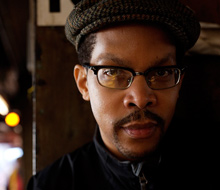For PSFK’s Future of Retail 2018 report, we sat down with Platform LA Founder and CEO Joey Miller to discuss how Platform is serving up an experience buffet at the convergence of fashion, culinary talent and creative companies with its popups, installations and food partnerships
We get it. If we mention the ‘A; word one more time when we talk about retail success, you’re going to implode. But let’s face it, the reason Amazon has become the ‘It Girl’ of the retail playground is because they’ve won the hearts and minds of retailers and shoppers alike with their, “Give me a C-O-N-V-E-N-I-E-N-C-E! What does it spell? Convenience!” chant.
According to Joey, the only way today’s retailers can start competing with Amazon’s cheerleading finesse is to start creating their own moves entirely. Rather than trying to beat Amazon at selling commodities, they need to focus on offering what Amazon can’t: things people can discover and experience with all of their senses in a physical store and not on a screen, like food, exercise, wellness and state-of-the-art fashion.
Enter the L.A. mall, Platform, that’s doing all of this and more. The year-and-a-half-old space is a cluster of boutiques, workout studios, offices and restaurants by up-and-coming chefs, all housed in an Instagram-worthy refurbished industrial complex. As customers line up for the mall’s free yoga classes and stroll through its outdoor gardens, Platform is emerging as a template for a new kind of shopping experience.
PSFK: What are the important trends that you see that are shaping the future of physical stores and offline retail?
Joey: The way that that brand manifests itself today and the way that people consume that brand could be online, in a store or through an event. Those are the three big ways that I see it happening. I don’t think there is a future for purely physical stores. Likewise, I think the future for pure-play online stores isn’t as bright as it once was. It’s about the brand and whatever touch points it has across those three things: a digital physical store and physical and digital experiences along the way.
What do you see as the key strategies that retailers and brands should adopt in order to succeed in this new retail space?
I think Amazon has such an enormous leg up on any kind of commodity good that it’s going to be really difficult for people to catch up with them. Obviously there’s Walmart and Target as well.
For anything commodity-related, like toothbrushes or razors, and I always shop online. I have two kids and I’ve never bought diapers at a store before. As the time gap between buying and getting products shrinks, as now you can obviously get things same-day and maybe even within an hour or two, Amazon or Walmart are your best bet at online fulfillment.
What’s left are the things that are interesting that people want to discover. Food, exercise and wellness. In the fashion space, it’s the unique things that have their own story and can’t be found in a commodity way on Amazon. There’s a uniqueness proposition that has to happen. Whatever you’re selling needs to be unique enough and you need to have to have a good enough relationship with your customer that people are going to come to you for it, rather than going the commodity route.
The future of retail will be about standing out from the commodity route and limiting the distribution that your brand has. There’s already plenty of great stores doing it, like Reformation or Shades of Gray that are both with platform. They basically do limited runs of their products and their products are only available through their channels or through very selective partners, in the case of Nordstrom’s.
It’s sort of mono-seasonal with certain drops or releases throughout the year, and not following the typical spring or fall calendar. They do a limited amount both to keep scarcity up and to test it out. If it’s successful they can easily turn up the dial because they’re designing and procuring their own products, so they’re not reliant on other people.
Again, it’s the move away from the wholesale retail model and more to ownership of the entire supply chain. If you can own the whole supply chain and you’re not seasonal, you don’t have to discount and you can control your inventory and product availability.
How is Platform using content education and experiential activations to give customers a reason to visit its physical stores and deepen its customer relationships?
It’s two-sided with us, because we’re in the real estate business not the clothing business or the retail business. Number one is the customer’s relationship with Platform itself. And number two is what we are imposing on our partners who populate our buildings, that they must do to deepen their customer relationships.
At Platform, we carry out all kinds of initiatives to deepen the customer’s relationship with Platform. When you think about Platform, customers are not coming necessarily because they want to visit any of the stores. They want to develop a relationship with the Platform brand.
Tell me a bit more about the values and attributes of the Platform brand with which you’re wanting customers to build affinity.
It’s a collection of unique, independent merchants and chefs that you can’t find anywhere else. Even though we might have a Sweetgreen or an Aesop, what is on offer in our physical space is different from any of their other locations. For example, at our Sweetgreen, which is called the Lab, the head chef is always testing out new recipes. There are salads that you can get there that you can’t get anywhere else.
Mandating that our partners are doing something completely unique for Platform is the beginning of defining who we are. We communicate that on our website and social channels, and encourage our customers to follow us on social. A shopping center really engaging in the social media world is definitely something new.
We’re also rolling out a program called Platform Select next year, which is comprised of a close community of people who visit Platform a lot. It’s an invite-only program where you’ll be able to receive all kinds of perks, as a way to deepen customer engagement.
Then conversely, we’re going to every one of our tenants and asking, “What are you doing that’s unique? How are you building your community? How are you engaging online and offline? How are you servicing the customer?”
Digital Oxygen’s founder once said that the retail box needs to represent more than just a shopping destination. It has to immerse you in the brand, teach you something new and help you make better purchasing decisions. How is Platform providing shoppers with more confidence around their product purchases and lifestyles?
It’s always our preference that customers can actually come in and purchase something at our stores. That said, if there comes a day where we have a brand at Platform and they do 75 percent of their sales online and only 25 percent in the store, I don’t think there’ll be any problem with that because these stores are becoming ways to engage with and connect with the customer, and serve as hangout spaces for that community. Essentially, they’re incredible customer-acquisition front-facing pieces.
We’ve invested in a couple of new brands who mostly sell online. They came to us and said, “Our customer acquisition costs are $100, and we think the lifetime value of that customer is $800, so we’re going to invest $100 and make $600 of after-cost profit on these guys.” Then we say, “Why are you spending $100 acquiring a customer with online ads? We can build a store for pretty cheap, and even if the store just breaks even, you’re acquiring all these new customers at effectively zero.”
A lot of these online native brands are starting to see the value in stores as front-facing customer-acquisition pieces. Instead of spending so much on advertising, they’ll think, “We can spend a quarter of that and acquire so many more people with a store.”
People no longer think of shopping malls as just shopping malls, but more of an evolution of a community center. As the digital world develops, there’s never been more of an emphasis on human-to-human connection with real conversations and events. What are your thoughts on how retail stores should be community spaces that focus on experiences that bring people together around the halo of a brand?
It’s just a no-brainer to me. These stores aren’t just places where you open your doors and hope people come in and buy stuff. My wife went to go buy clothes for our kids and went to store that we all know in a fancy shopping mall that just opened in LA. The store had none of the things that she was looking for, even though she’d seen them all online. She came back and said, “Why should I ever go to the store? The most convenient store is online.”
The question then becomes, “Why would you go to the store?” For Lululemon, it’s for yoga classes in the place. Reformation started by selling vintage in its store. Now it hosts a vintage fair outside of the store every Sunday.
At Platform, you offer free yoga classes, workout studios, restaurants with up-and-coming chefs and outdoor gardens. Can you talk a little bit more about how you are capitalizing on the continued growth of the wellness marketplace?
Firstly, people are more passionate about working out and being healthy than ever before. Secondly, it’s a great way to get people together. Three out of four people that I know that do SoulCycle are like, “It’s not the greatest class that I go to in terms of fitness, but I love going there because I love seeing my friends. I love the community.”
It’s that spirit that’s very effective when hosting fitness programming. What better way to get customers to come to a store than through fitness classes?
How do you approach tracking people’s experiences in your stores?
This is one instance where you need a little bit of human curation of data. It’s nice to have all those metrics, time spent in the store or location-based advertising, where it’s pushing coupons to you if you’re walking by the place. That’s all technology that exists, but I think that good, old clienting is really the important element here—that each store manager or community curator is armed with all of the data.
That way, they have people within five miles that have bought online from this brand, plus all the people that have come in the store. They’ll be able to cross them with each other and send them a note saying either, “Hey, thank you so much for coming into the store. Come visit us again, and you can always find us online 24/7 here,” or, “We notice that you live nearby. We’d love to have you come visit the store.”
It’s important to use the data to send out bespoke, personalized messaging to customers. Maybe you could throw an event for your top 50 spenders across all platforms. What technology does is it’s going to enable real human beings to make good clienting decisions and manage their CRM in a very effective way.
How do you think brands should utilizing technology to improve shopping experiences?
If you talked to me three years ago, I would have told you that everyone will be wearing Google Glass. You’ve got to see what people are starting to adopt. The amazing thing is that technology and pricing is moving at a pace where the second something becomes widely adopted, it’s very easy to buy into.
The transaction pain point is not the biggest thing to me. In store, it’s easy to swipe your card and online, obviously, if you have information stored, it’s easy to do. As we develop out Platform as a brand, what we’d love to do is find a way to have a deep enough relationship with our Platform Select members where we use PayPal or Apple Pay to effectuate payment throughout Platform. We’re not quite there yet. If you can build up the relationship, then making that ask to keep a credit card on file is not a stretch.
At Platform, customers never know what they’re going to find when they come back to the store, tapping into that element of surprise. Mark King, President of Adidas North America, once said that, “If our store was purely just full floors of product, people would come once to the store, but they probably wouldn’t come back again. The challenge is to keep it constantly changing, so people have a reason to come back.” How do you approach programming your retail locations so you constantly update the products and experiences to keep the stores feeling fresh and exciting?
Firstly, we keep four of the stores as rotating experiences. The longest term that someone will be there is three months. So at the very least, customers know that there will always be new things at these four spaces. Secondly, we host at least two events per month. We work with our retailers and restaurateurs on these events. So customers are going to come back every time and find something different in terms of new stores and partners and events such as yoga classes, wine tastings, concerts, car shows and so on.
Can you give me a little bit of a hint on what’s on the horizon for Platform in 2018 and beyond?
In 2018, we’re opening two more restaurants and we’re building six more stores next to Platform. We’re also going to launch Platform Select, as I mentioned, which is a Platform community for special perks and events. We already have 2018 programmed out with at least one event per month.
We hosted Small Business Saturday the week of Thanksgiving which was a crowdsource market. Essentially we went out to our entire community and said, “We are big believers in small business and entrepreneurs. Nominate a brand that to come to Platform for Small Business Saturday and we’ll set them up in a little marketplace and let them show their wares to the Platform community.” Then we took that to our current base of tenants, and said, “Here’s the hundreds of applications that we’ve gotten. Who do you think would be good?”
We also used our social application to bring people to come out and celebrate entrepreneurs. That’s an example of a nice feedback loop of social to physical. We’ll do a lot more programs like this in 2018!
For more information on how companies can transform their physical stores into experience centers that extend their supply chain and digital commerce platforms, check out PSFK’s Future of Retail 2018.

